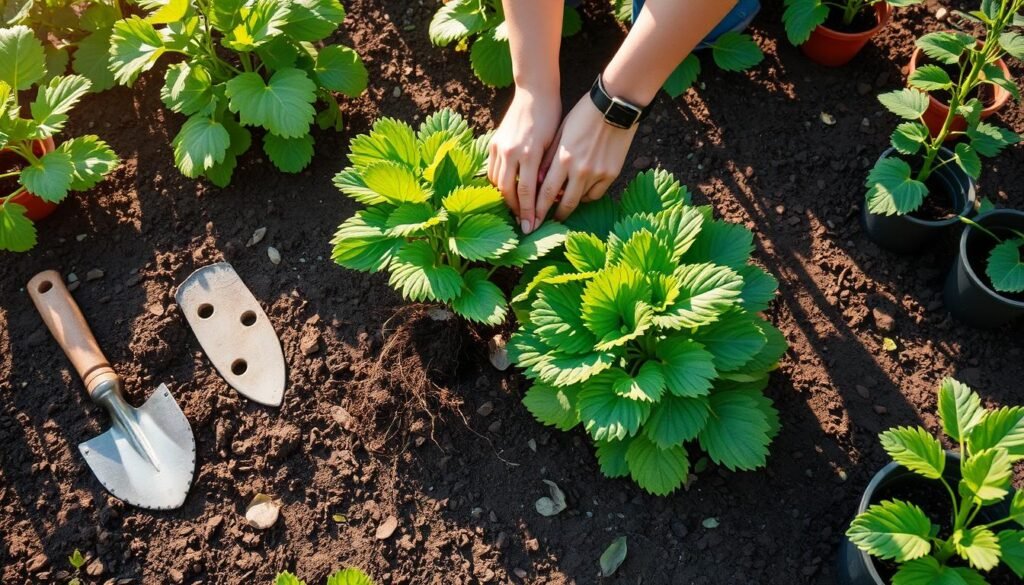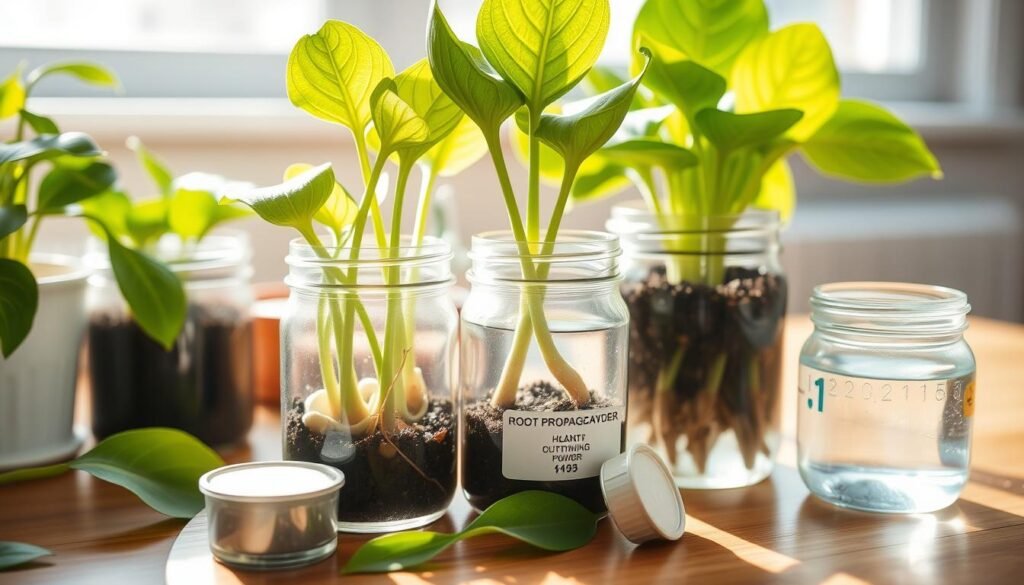Learn how to multiply your garden’s bounty at home. This guide explores plant reproduction techniques.
You’ll learn to create new plants from existing ones. This skill helps expand your plant collection cost-effectively.
We’ll cover seed sowing, stem cuttings, and leaf propagation. You’ll also learn about air layering.
Grow your own plants from scratch. Save money and reduce your environmental impact.
Understanding the Basics of Plant Propagation
Plant propagation creates new plants from seeds, cuttings, or divisions. It helps gardeners grow new plants from existing ones, keeping desired traits.
There are two main methods: sexual and asexual propagation. Sexual propagation uses seeds, allowing for genetic diversity.
Asexual propagation uses cuttings, divisions, or layers from existing plants. This method keeps desirable traits in new plants.
The most common plant propagation methods are seed propagation and stem cuttings. Leaf cuttings and division are also popular techniques.
Each method needs specific care and attention. Learning these methods for growing new plants from cuttings is key.
Mastering plant propagation helps expand your garden collection. You can share favorite plants and save money on new ones.
This practice opens up many possibilities for gardeners. It’s useful for both beginners and experts alike.
How to Propagate Plants: Step-by-Step Methods
Growing plants at home can be fun and save you money. You can use many ways to make new plants from old ones.
Stem cutting is a popular method. Cut a healthy stem and put it in water or soil. Soon, it will grow roots. If you are looking for the best Website, you can Visit here for more information: aroid mix
Leaf propagation works like stem cutting. Use a leaf instead of a stem to grow a new plant.
Division is great for perennial plants. Dig up the plant and split its roots. Then, replant the parts in new pots.
Give new plants what they need to grow. This includes sun, water, and good soil. With care, you can make many new plants.
Seed Propagation Techniques for Beginners
Seed germination is a great way to grow new plants. This guide will help you start your plant propagation journey.
Choose high-quality seeds for the plants you want to grow. Check the seeds’ needs for temperature, moisture, and light.
Store seeds in a cool, dry place until you’re ready to plant. This step is important for good results.
Prepare your soil or seed mix before planting. Follow the needs of your chosen seeds.
Plant seeds at the right depth and space. Water them gently after planting.
Keep an eye on soil moisture. Give seedlings the right amount of light.
Be patient as your seedlings grow. Give them the care they need to thrive.
Move seedlings to bigger pots or your garden when they’re strong. With these tips, you can grow plants from seeds.
Stem Cutting Propagation Methods
Growing new plants from cuttings is a popular method. Stem cuttings offer an easy way to multiply your favorite plants at home.
There are different types of stem cuttings. These include softwood, semi-hardwood, and hardwood cuttings.
Softwood cuttings come from new, succulent growth. Semi-hardwood cuttings are from partially mature stems.
Hardwood cuttings are taken from mature, woody stems. Each type has its own rooting needs.
The key is creating the right conditions for roots. This means using well-draining soil and providing enough moisture.
Proper temperature and light are also important. With these steps, you can easily grow new plants from cuttings.
Leaf Cutting: Growing New Plants from Leaves
Leaf cutting lets you grow new plants from leaves. It’s a great way to multiply your favorite houseplants.
You can make new plants that are just like the old ones. This method works well for many types of plants.
Propagating plants from leaves is easy to do. African violets, begonias, and succulents are good choices for this.
First, take a healthy leaf from the plant you want to grow. Make sure to get the whole leaf and its stem.
Put the leaf in soil that drains well. Bury the stem but keep the leaf above the dirt.
Water the soil a little. Don’t use too much water or the leaf might rot.
Give your leaf bright light, but not direct sun. Keep the soil damp but not soaked.
Be patient. It can take weeks or months for new roots to grow.
When the new plant is big enough, move it to its own pot. Now you have a new plant from just a leaf!
Division Propagation for Perennial Plants
Plant division is a popular way to grow perennial plants. It involves splitting a plant into sections, each with its own roots.
Spring and fall are ideal times for dividing perennials. Choose plants that have become overcrowded or overgrown for best results.

To divide a plant, dig it up entirely. Use a clean knife to cut the root ball into sections.
Replant the divided sections right away. Water them well and give them the same care as before.
Division is an easy way to get more perennial plants. You can grow your garden without buying new plants.
Air Layering: Advanced Propagation Technique
Air layering is a cool way to make new plants. It works great for woody plants and trees.
You create new roots on a stem still attached to the parent plant. This method uses moist moss wrapped around the stem.
To start, pick a healthy stem with a node. Wrap the node in wet moss and cover it with plastic.
Keep the moss damp and wait for roots to grow. This can take a few weeks or months.
Once roots appear, remove the plastic and cut below the rooted section. Now you have a new plant ready for potting!
Air layering lets you make new plants from old ones. With care, you can grow many woody plants this way.
Water Propagation: Growing Plants in Water
Water propagation is a unique way to grow plants. It involves rooting plant cuttings in water before moving them to soil.
This method works for many plants. These include houseplants, herbs, and some outdoor plants.
Water propagation is easy and simple. You can watch roots grow in clear water.
Some plants that are hard to root do well in water. These include succulents and tropical plants.
To start, cut a healthy stem from the parent plant. Remove leaves that would be underwater.
Place the cutting in a clean container with water. Keep the water fresh and topped up.
Roots should appear in a few weeks. Then, you can move the plant to soil.
Water propagation is fun for home gardeners. It’s a great way to grow your plant collection.
With this method, you can easily make new plants. You’ll create thriving specimens using just water.
Root Hormone Usage and Application
Root hormones can boost plant propagation success. They help grow new plants from cuttings more easily.
Auxins are chemicals that promote root growth in cuttings. They trigger new root cells to form.
These hormones help cuttings get water and nutrients. They’re useful for stem and leaf propagation.

Follow instructions when using root hormones. The right amount and time are key.
Dip the cutting’s base in hormone solution briefly. Then plant it in soil.
Using too much can stop roots from growing. Apply sparingly for best results.
Root hormones help you grow more plants. You can expand your collection and share plants.
Practice makes perfect with plant propagation. Soon, you’ll enjoy the fruits of your labor.
Common Plant Propagation Problems and Solutions
Plant propagation can be rewarding, but it has challenges. You may face issues when growing plants from seeds or cuttings.
Rotting cuttings is a frequent problem in plant propagation. Overwatering, poor drainage, or fungal infections can cause this issue.
To prevent rot, use a well-draining medium. Cut with a clean, sharp blade. Apply rooting hormone to boost growth.
Slow root development can frustrate gardeners. Inadequate light or low temperatures may cause this problem.
To speed up root growth, provide proper light. Keep temperatures optimal for your plant species.
Pest infestations can threaten new plants. Aphids, mealybugs, and spider mites are common culprits.
Check your plants often for pests. Use insecticidal soap or neem oil to control them.
Solving these issues will boost your success rate. You’ll enjoy growing new plants from existing ones.
Conclusion
This guide covers many ways to multiply your plants at home. You can now overcome plant propagation challenges and grow new plants.
These strategies help expand your indoor or outdoor garden. Try different methods to find what works best for your plants.
Enjoy watching new life grow as you propagate. With care and patience, you’ll create a beautiful plant collection.
Your home and garden will soon be full of color and life. Happy plant growing!
